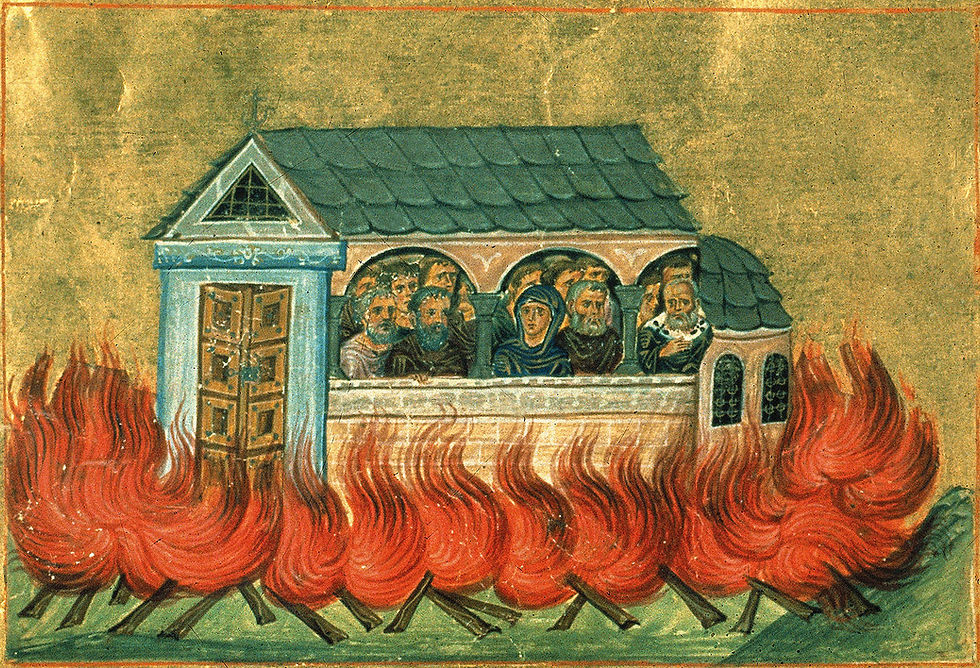Evil, Women and Misogyny
- Tim Boatswain

- Apr 12, 2022
- 4 min read
Updated: Mar 22, 2023

Last month Channel 4 ran a three-part series on the Moors Murders, rehearsing the heinous crimes of Ian Brady and Myra Hindley. It received a lot of criticism as to why we should be reminded of this infamous couple and as one reporter commented ,“It’s unfortunate that they will be long remembered. I think it would be better if they were totally forgotten.”
The programmes recalled a point I made when I gave a talk at St Albans Cathedral back in the summer of 2020 on The Nature of Evil: the media's focus, and by association the public's interest, was, and still is, directed much more on the female accomplice, Myra Hindley, than on the male instigator Ian Brady.
It seems that somehow it is more terrifying and reprehensible for a woman than a man to be associated with such cruel violence and vicious murders. This is especially so because it appears the motive was sexual pleasure gained through inflicting pain and ultimately death upon children. The killing of innocent, powerless victims is perceived as particularly inhuman and evil. The question has been asked, 'How can a woman, who is stereotypically associated with care and nurturing (the qualities of motherhood), step beyond her feminine nature and become a sadistic murderer?
In many cultures, however, women have been, and still are, equated with irrational dark forces: for example, in Europe the concept of a witch, usually perceived as an older woman, a spinster who, therefore, is not integrated into the traditional (normal) structure of society: marriage, parenthood and so on. The now commonplace modern social explanation of equating women with evil elements of life has been the dominance of patriarchy, whereby the association of women with dangerous and destructive forces has been used as a means of control by subordinating the female of the human species to the male.
A more symbolic interpretation of male control over females has connected women with the uncontrollable forces of nature which must be contained if human society is to survive. The argument goes that women through their biology, their association with the unpredictability of birth and life, are aligned to the untameable forces of nature. The hysterical ( meaning those with wombs) present a threat to rationality and order, which is required by a civilised society. The Ancient Greek playwright Euripides focussed on this cultural construction in his play The Bacchae, where Pentheus, the King of Thebes, is eventually torn to pieces by wild, uncontrolled, women, including his own mother, who has returned to nature through the cult of Dionysius (Bacchus in Latin). So fearful were the Roman senators that their Republic might be overthrown by such wild riots that they outlawed the cult of Bacchus.
In particular women's sexuality across many cultures was, and is, often perceived as dangerous. The association of women with danger and evil, for example, is deeply embedded in Judaeo-Christian culture. In the Old Testament, women are suspect and destructive, from the fall of Eve in Genesis to the vitriolic attack on Jezebel whose "whoredoms ...and witchcrafts are so many" (2 Kings, 9.22).
The Early Church, along with Judaism, was also greatly influenced by the Near Eastern (Persian) duality of good and evil and natural urges were perceived as dangerous. St Paul was to advise in Corinthians (1,7,1-2), " It is good for a man not to touch a woman". and Ecclesiasticus, the author of an apocryphal gospel exclaimed, "All wickedness is but little to the wickedness of a woman". St Augustine of Hippo argued that concupiscence was the source of perpetuating Original Sin and for the more extreme Christians, the ascetics, priestly celibacy was not enough, women were perceived as the devil incarnate, leading to carnal temptation.
The fear of women's sexuality has pervaded much history and even at a local level in St Albans we have a demonic sculptural illustration of the need to tame women's lustfulness in a succubus (her goat's feet shackled) at the end of the Christopher Inn passageway:
Linked to this cultural fear of the female is the phenomenon of misogyny: the hatred of, and prejudice against women. It can be observed across many societies and is often deeply embedded in cultural practices as well as psychological traits. Paradoxically, as more nations embrace human rights and preach egalitarianism and equality there appears to be an increase in misogyny. Often fuelled by social media, some would argue some misogyny is a consequence of populist and identity politics - the fear of the other.
The anger and violence displayed at a personal level by some men towards women may be rooted in their conflicting feelings about the female: both in terms of their dependency for procreation and nurture but also fear of women's power over them. In August last year in Plymouth, a 22-year-old man, shot his mother and went on to kill four other people, injuring two others before fatally shooting himself. It turned out that he had been watching videos published by an organisation called Incel, where discussions in an internet forum are characterised by self-pity, resentment and the hatred of women. This division between men and women has its echoes in a growing tribalism where there are 'haves' and 'have-nots' ( see my blog on tribalism: https://timboatswain.wixsite.com/website/post/something-big-is-coming).
In modern society the traditional roles attributed to males and females have been subverted and, as a generalisation, there are those young, and often uneducated, males who feel displaced and inadequate in a competitive world. It seems that some focus their blame on women, the 'other'. It is unrealistic to think that both tribalism and the misogyny can be completely eliminated soon as their evolutionary roots are deep: the Scottish polymath, David Hume, opined, “Nature is always too strong for principle.” But it is the role of civilisation, which must keep striving, to raise humanity to a better, fairer and humane world.




Comments